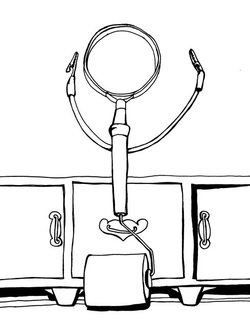 JACQUELINE LAWTON: Why did you decide to get into theatre? Was there someone or a particular show that inspired you? CECILIA CACKLEY: I think every performance I saw when I was young inspired me in some way. With puppetry, I’d say it was the retrospective exhibit on Julie Taymor at the National Museum of Women in the Arts in 2000 that opened my eyes to the possibilities of puppetry as an art form. I had taken some puppetry classes and was part of a teen puppet troupe in Arlington County one spring, but the video, photographs and puppets that were displayed at the museum showed me that there was a huge world of storytelling in puppetry beyond anything I had encountered before. JL: Wit’s End Puppets was established in 2011. What inspired you to form this company? What contribution do you hope to make to the D.C. Theatre community? CC: I wanted to try and form a space to experiment with using puppets to tell stories and a group of people interested in learning about different kinds of puppetry. I think that if more people are working and performing with puppets, more people will learn about what an amazing and inspiring art form it is. I hope that we become a resource for other companies looking to incorporate puppetry into their work. I hope that we can create performances that reach as many different communities as possible, in all parts of the city. JL: In addition to performances, Wit’s End Puppets has conducted workshops at elementary schools in D.C, Maryland and Virginia. Can you speak a bit about this work and the importance of arts in the schools? CC: I’m a former elementary school teacher and I think that it is supremely important for students to have the opportunity to create work in a setting where there are no right answers. As more and more of the curriculum is tested, kids as young as five are learning to only worry about whether or not they are ‘right’ and that makes it hard for them to take risks, and fail, which I think are necessary to true learning. The arts are still in some ways a refuge from that kind of thinking, a place where students can create according to what they believe is right, rather than what the state tests believe is right. Puppets are a fantastic way to teach problem solving because there are thousands of ways to create a puppet, without any expensive materials or fancy skills. For a student to imagine a character, envision it as a puppet and then see it through to completion all by themselves is incredibly empowering. As someone who can be quite shy, I also appreciate the fact that for a student doesn’t like performing, a puppet gives you an object to hide behind. JL: What excited you about taking part in the Mead Theatre Lab at Flashpoint? What have you learned from this experience? CC: The most exciting thing for me is having a place to build a set and leave it there for a whole month! Everything else we have created was intended to break down so it could fit in a car and be set up in twenty minutes for a Fringe venue. The stability of having a space is allowing us to create something very different from anything we’ve done before. I’ve learned a lot about devising and how it is in some ways more challenging with puppets than with actors. I’ve learned a lot about organization and producing and the whole thing has made me think a lot more about the structure of the company and how future shows could be put together. JL: What compelled you to create THE AMAZING AND MARVELOUS CABINETS OF KISMET? CC: After creating The Malachite Palace for Capital Fringe 2011, I knew I wanted to create another show with a group of people, rather than writing a script and building puppets on my own. When Genna, Nicole Martin, Lisi Stoessel and I (who all worked on Malachite together) met to talk about possible inspirations, it turned out that we all loved the work of the artist Shaun Tan. So Tan is really what compelled us to start experimenting with puppets and a storyline that would reflect his themes and aesthetic. I had just read his story collection Lost and Found, and I was mesmerized by his beautiful paintings with their strong themes of fear, change, alienation and hope. Throughout the entire process we have always gone back to Tan whenever we get stuck on something. JL: THE AMAZING AND MARVELOUS CABINETS OF KISMET is a collaborative endeavor. Can you speak about this process? What are some of the major challenges? What do you love about collaboration? CC: I love getting to hear opinions from different people and I think that collaboration means that construction problems get solved a lot faster. It can be challenging to keep everyone focused during rehearsal, and at times we have to pause and set questions aside to be answered later. I think that this story could only have come to life through collaboration, not least because of the number of hands needed. In puppetry, it’s definitely possible to tell a good story with just one or two people operating the puppets, but it’s so much easier when you have four! JL: Banished? Production’s brilliant, imaginative and talented Carmen C. Wong is serving as director on THE AMAZING AND MARVELOUS CABINETS OF KISMET. What has it been like working with her? CC: Brilliant. We’re incredibly lucky to have her. Carmen was part of the Mead Theater Lab program last year, so she’s been mentoring us a little on the production side of things and in the rehearsal room, it’s been great to have her eyes on the story, helping us shape the pieces of the narrative. In some ways, this project is more narrative-driven than much of what she does with banished? but at the same time, our companies share an interest in using objects to give an audience a particular experience. JL: You’re billing THE AMAZING AND MARVELOUS CABINETS OF KISMET as “the story of one puppet’s journey through fear and the unknown.” What can audiences learn from Kismet’s adventure? CC: I’m hoping that audiences learn lots of different things. One of the reasons we chose to make this show wordless was to try and make it accessible to the greatest number of people and to allow for many different interpretations of the characters and the story. On a very simple level, audiences will learn about the capabilities of familiar everyday objects which we are using to tell the story. On a deeper level, I hope audiences will identify with Kismet, our protagonist and his struggles with fear and finding a place in a strange world. JL: If there is one thing you want audiences to walk away knowing or thinking about after experiencing THE AMAZING AND MARVELOUS CABINETS OF KISMET, what would that be? CC: I hope that audiences will walk away with a slightly different perspective on change, which is probably the biggest theme in the show. I’d like audiences to think a little more closely about how we approach change and deal with change in our lives and world.  Wit’s End Puppets presents The Amazing and Marvelous Cabinets of Kismet Created by Genna Davidson & Cecilia Cackley Directed by Carmen C. Wong, banished? production April 24 to May 19, 2013 Mead Theater Lab at Flashpoint, 916 G St. NW $15, Students and Seniors $10 Call 202.315.1310 or visit www.witsendpuppets.com.
0 Comments
Your comment will be posted after it is approved.
Leave a Reply. |
My BlogI'm a playwright, dramaturg, and teaching artist. It is here where you'll find my queries and musings on life, theater and the world. My posts advocate for diversity, inclusion, and equity in the American Theatre and updates on my own work. Please enjoy!
Categories
All
Archives
June 2020
Reading List
|

